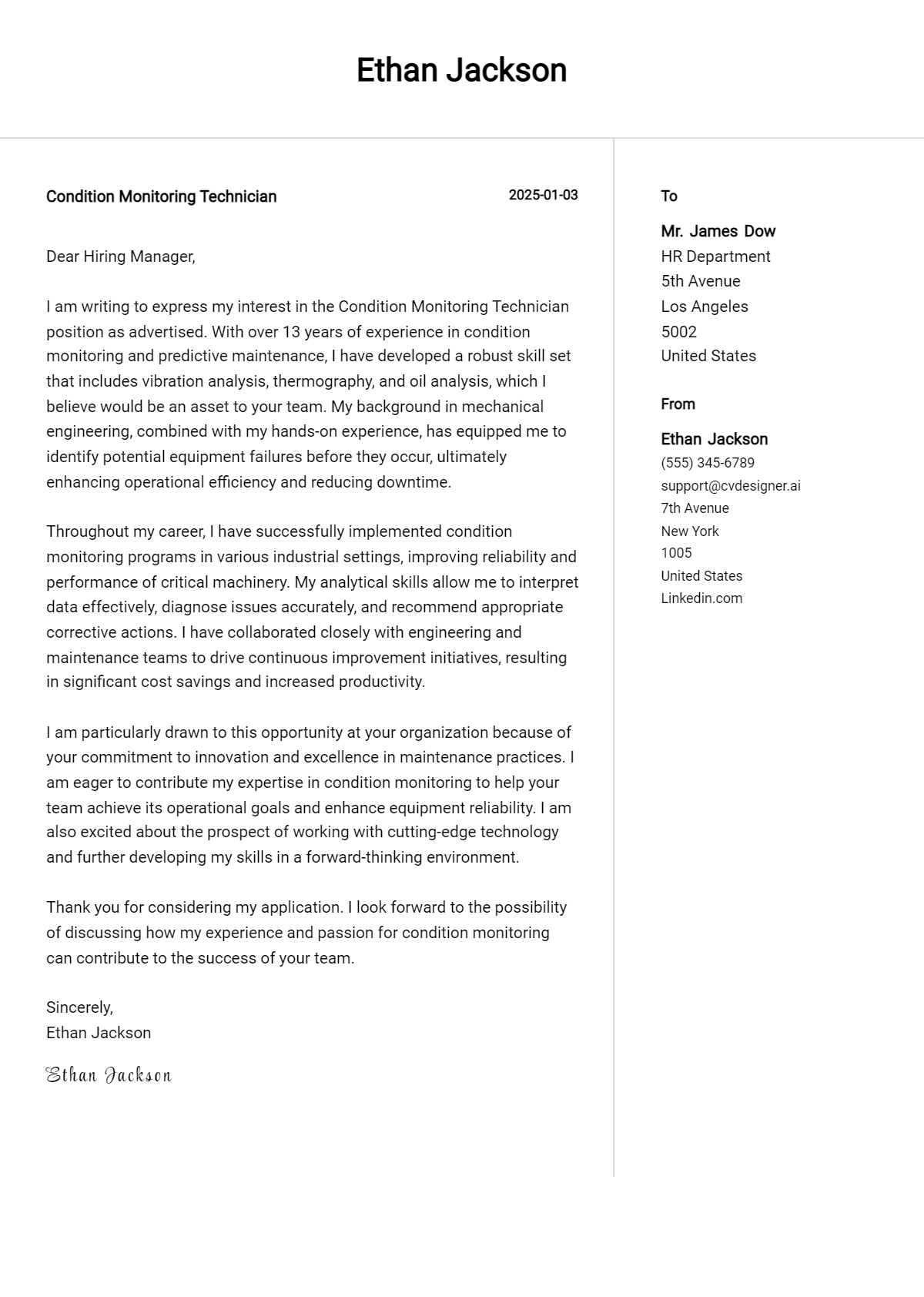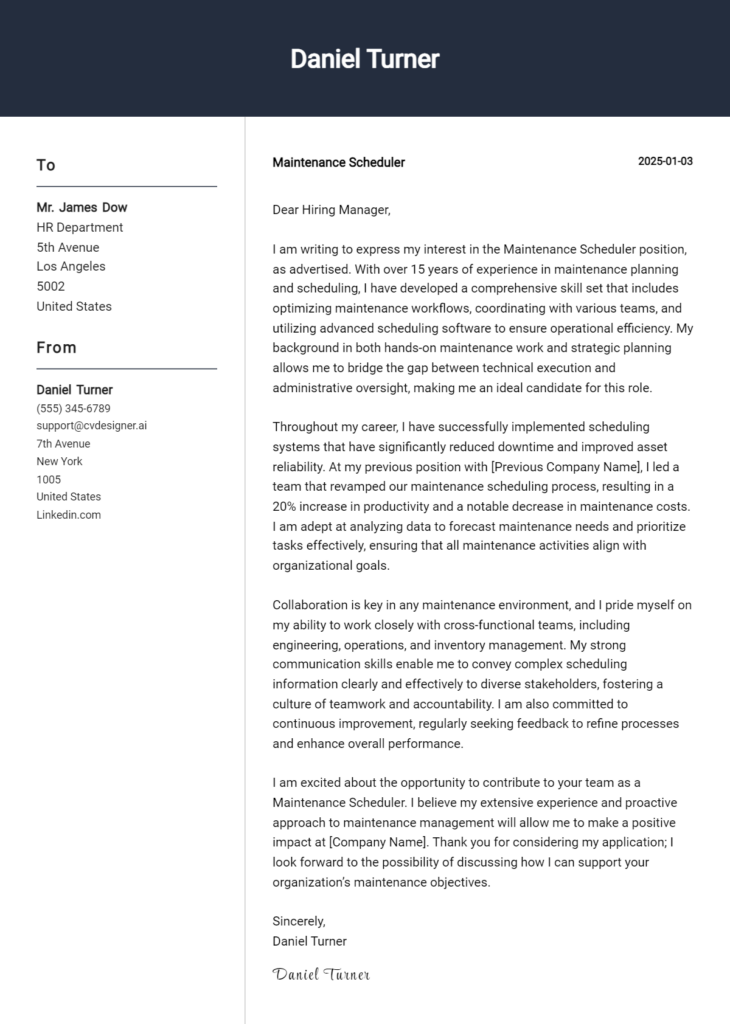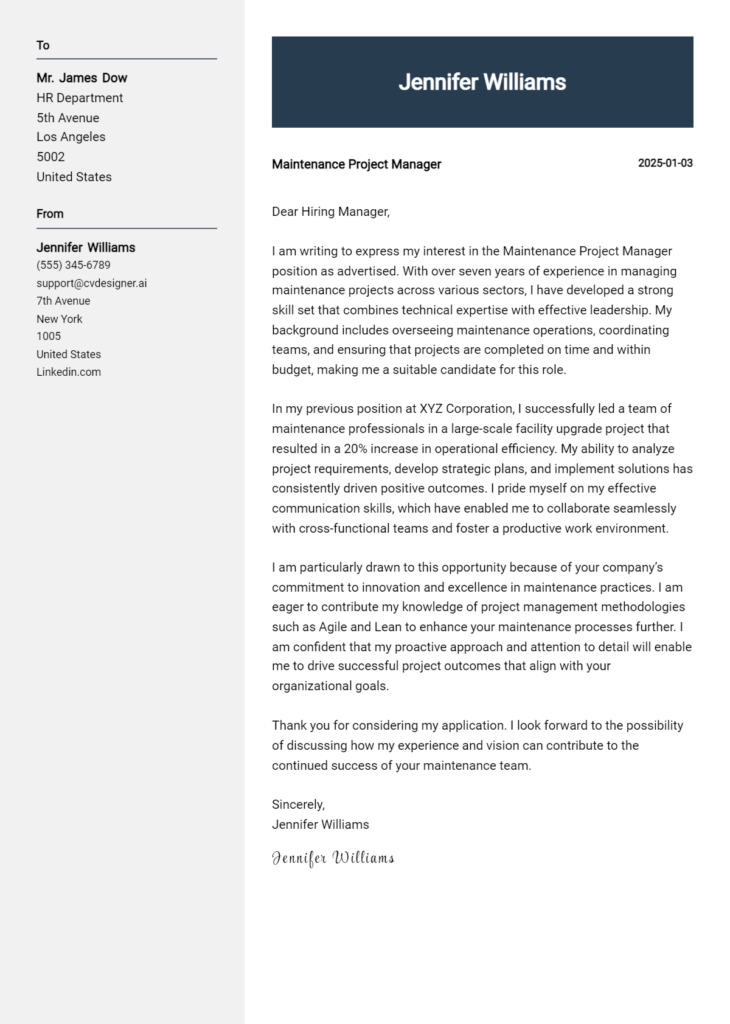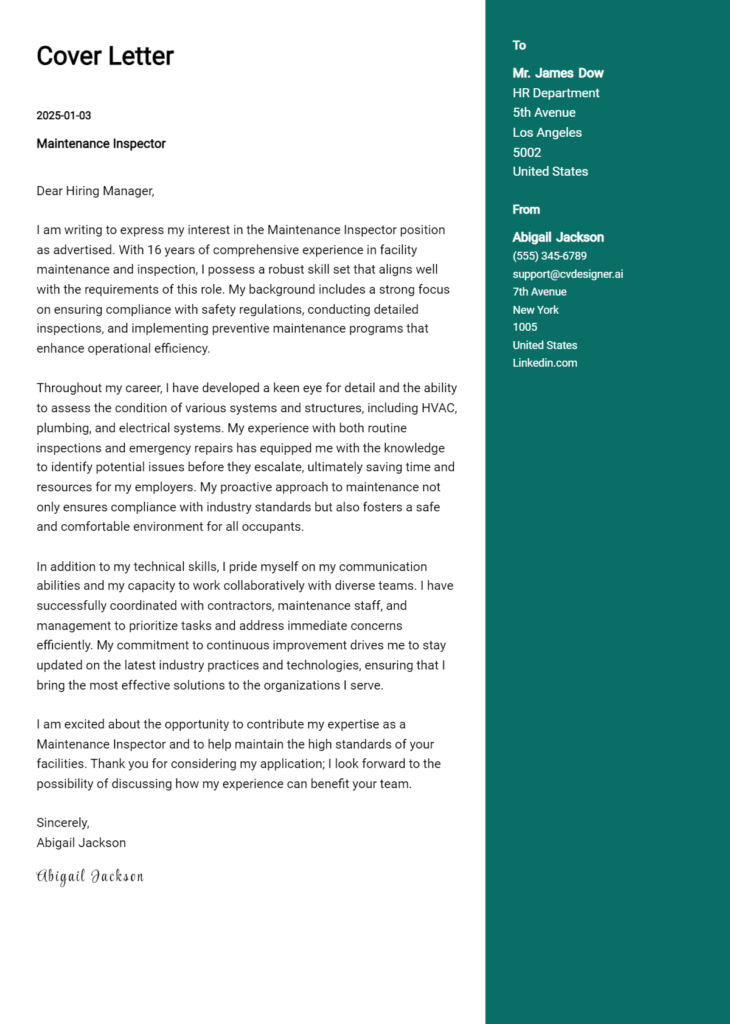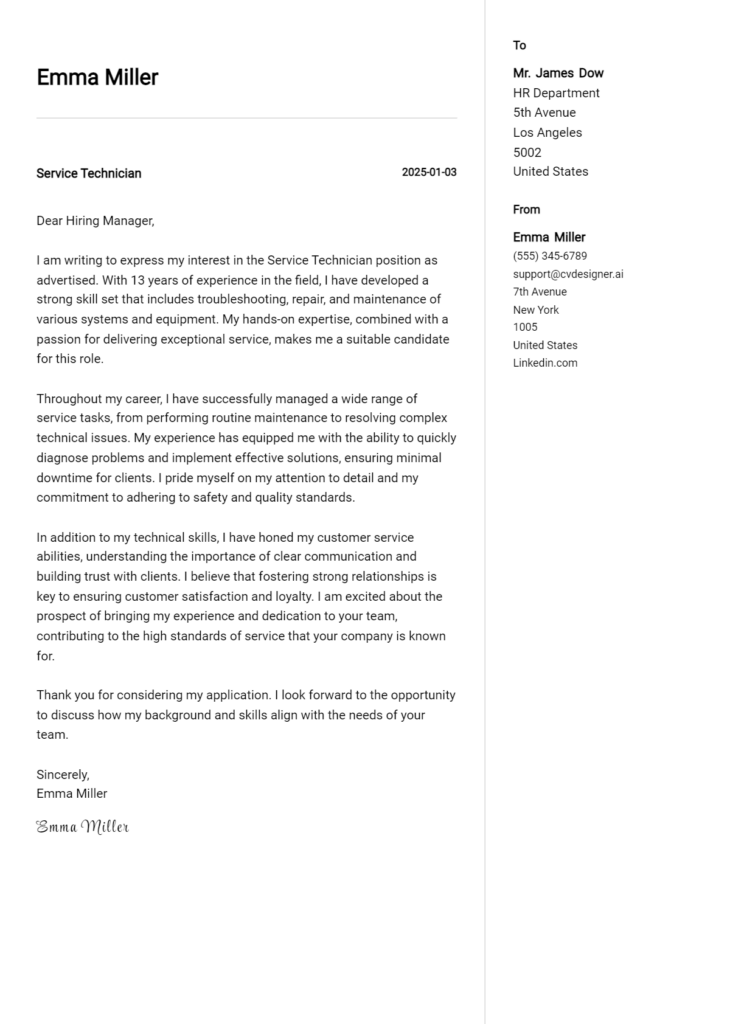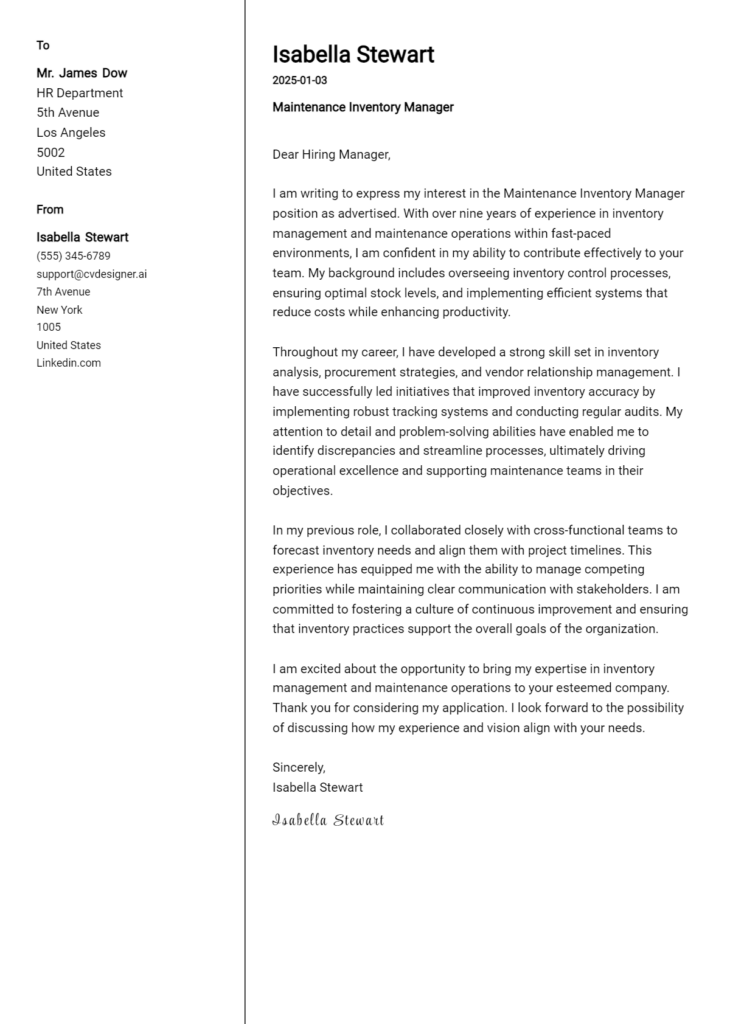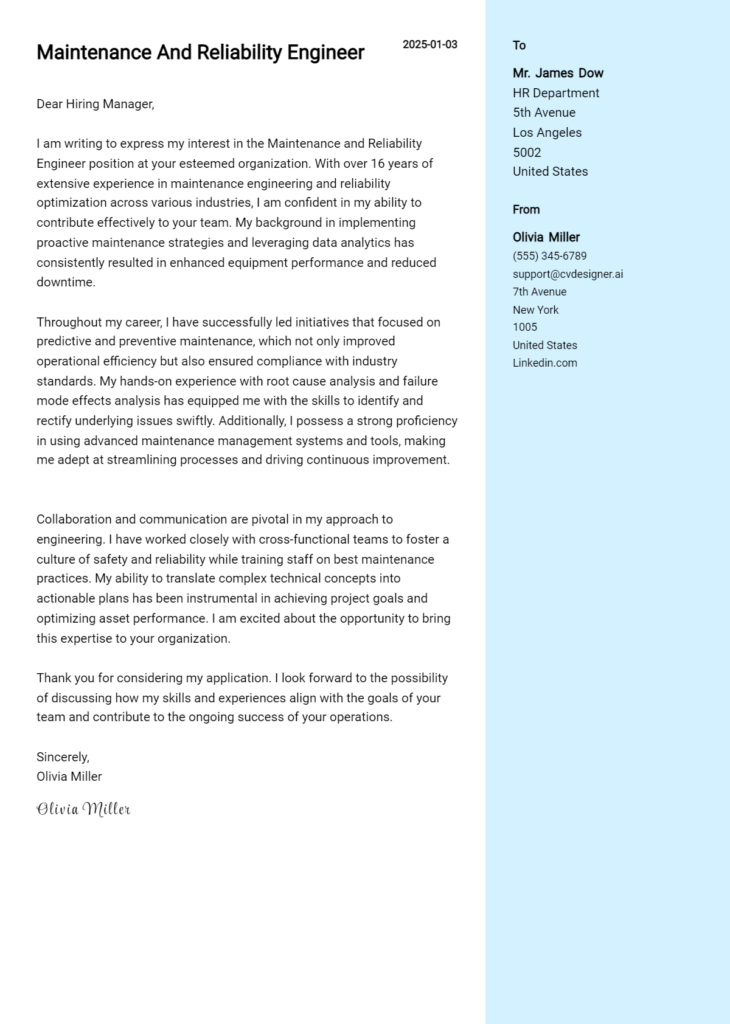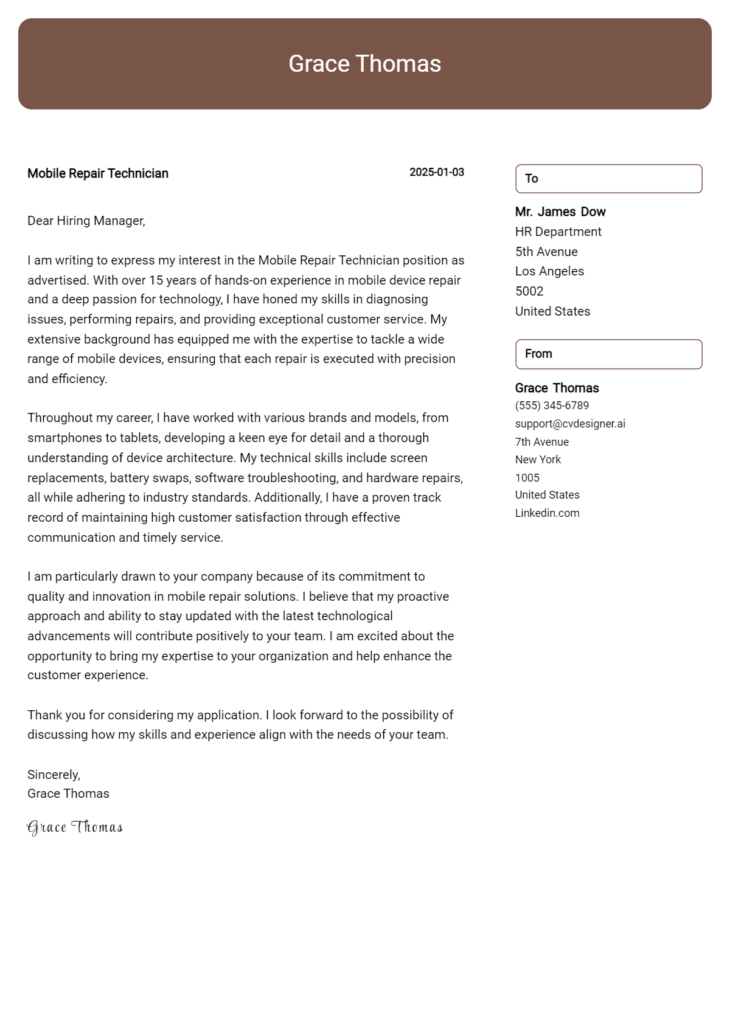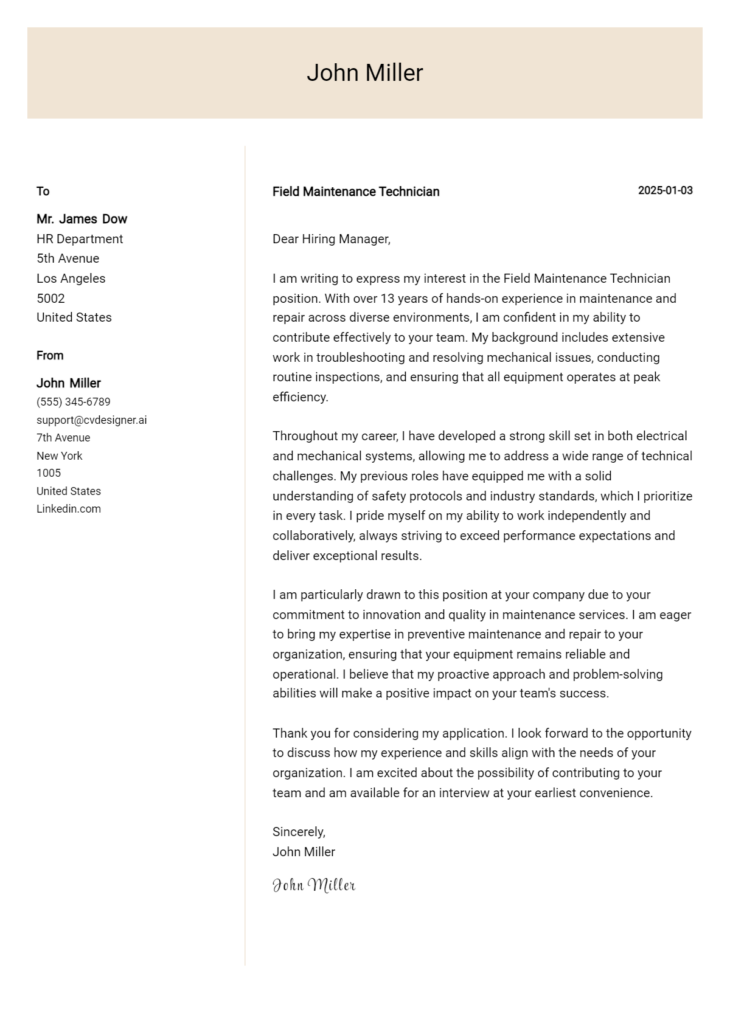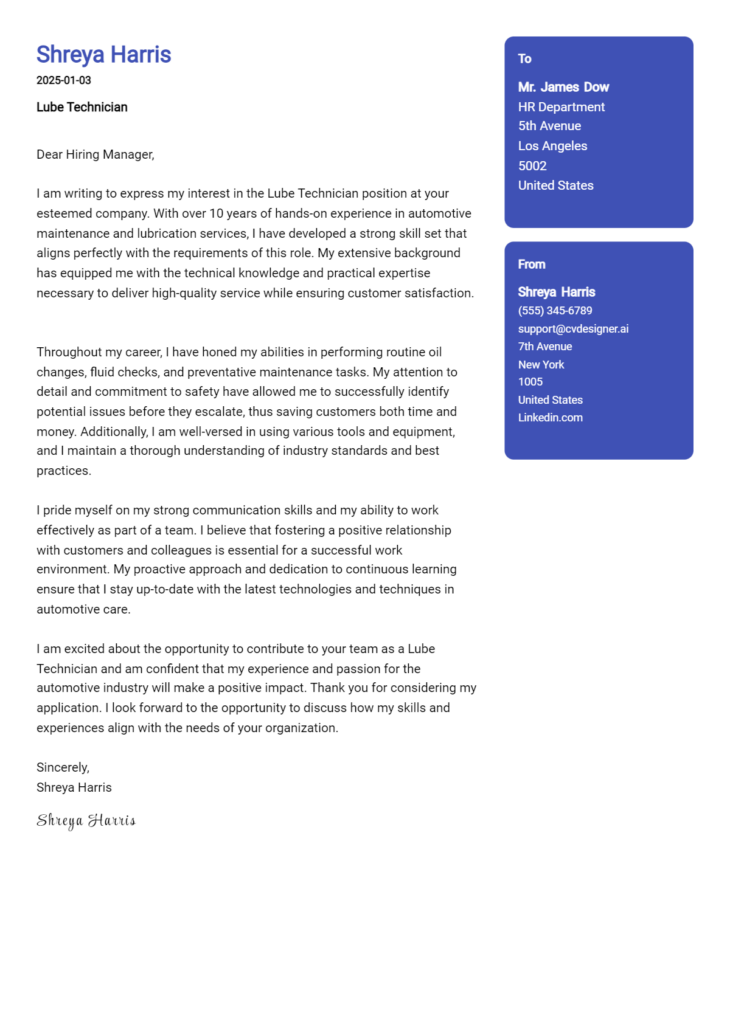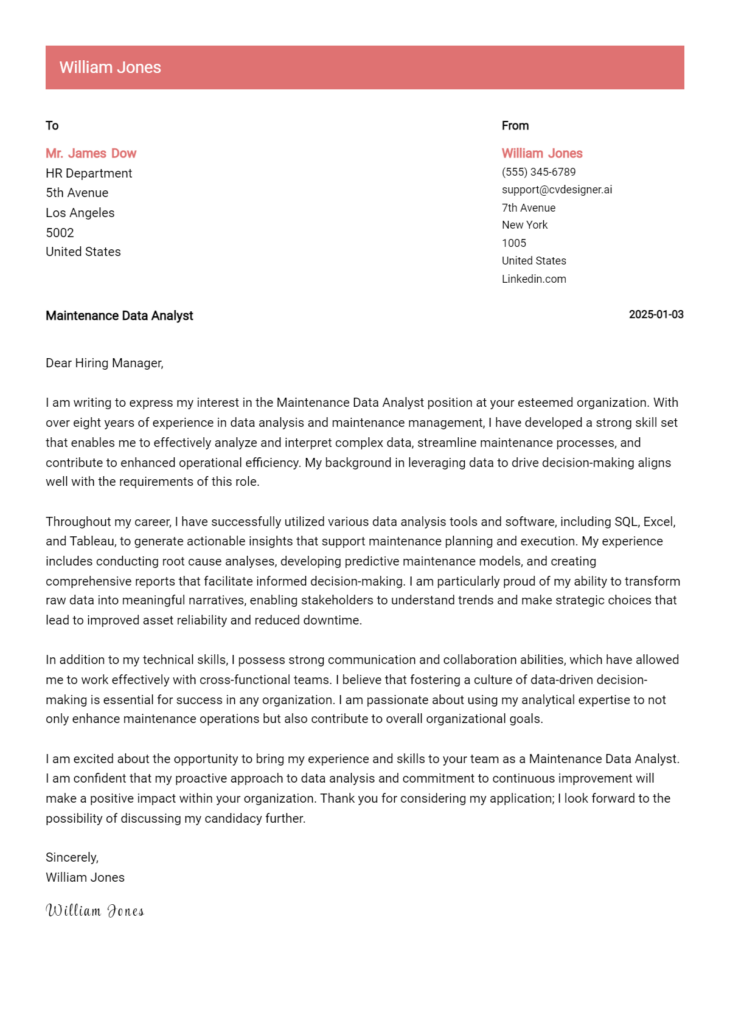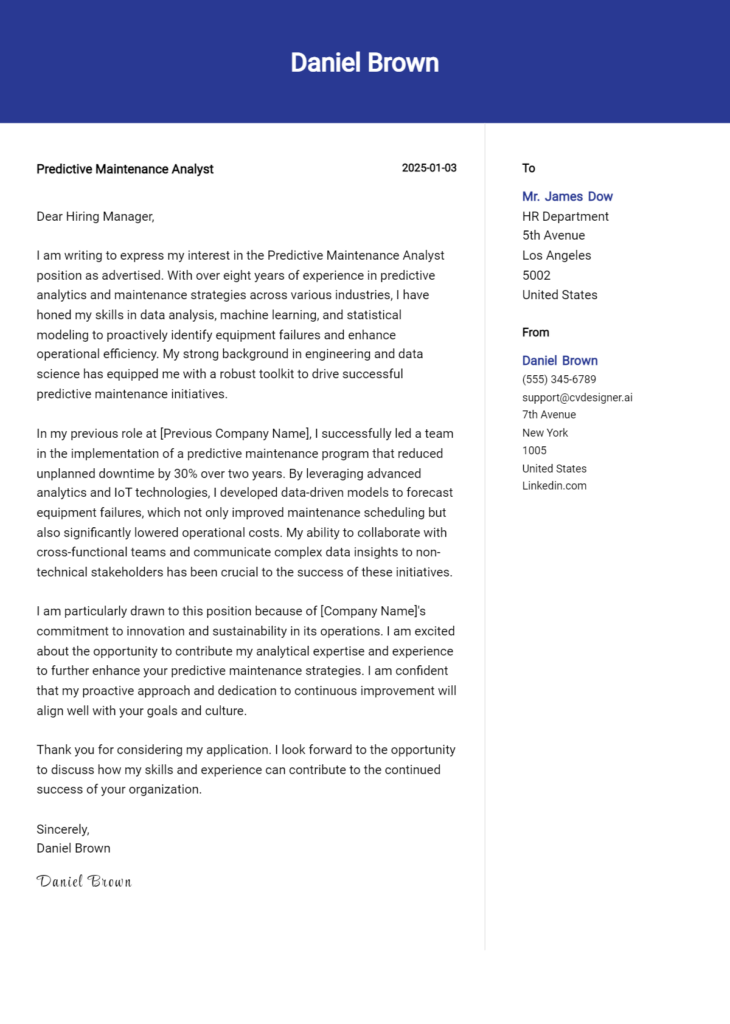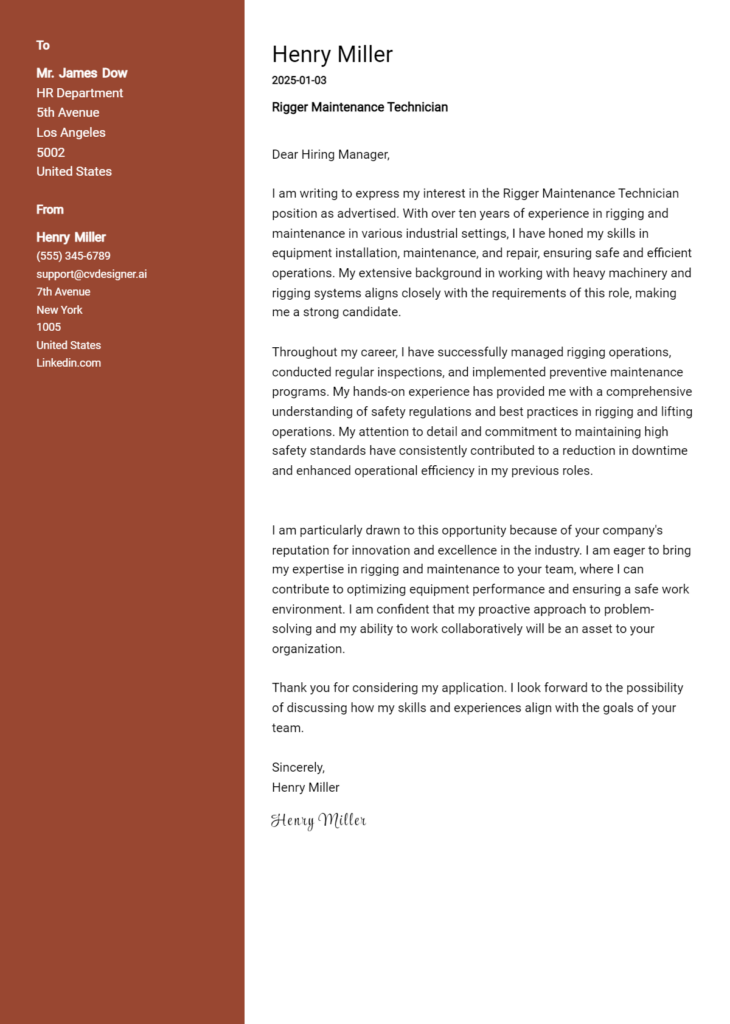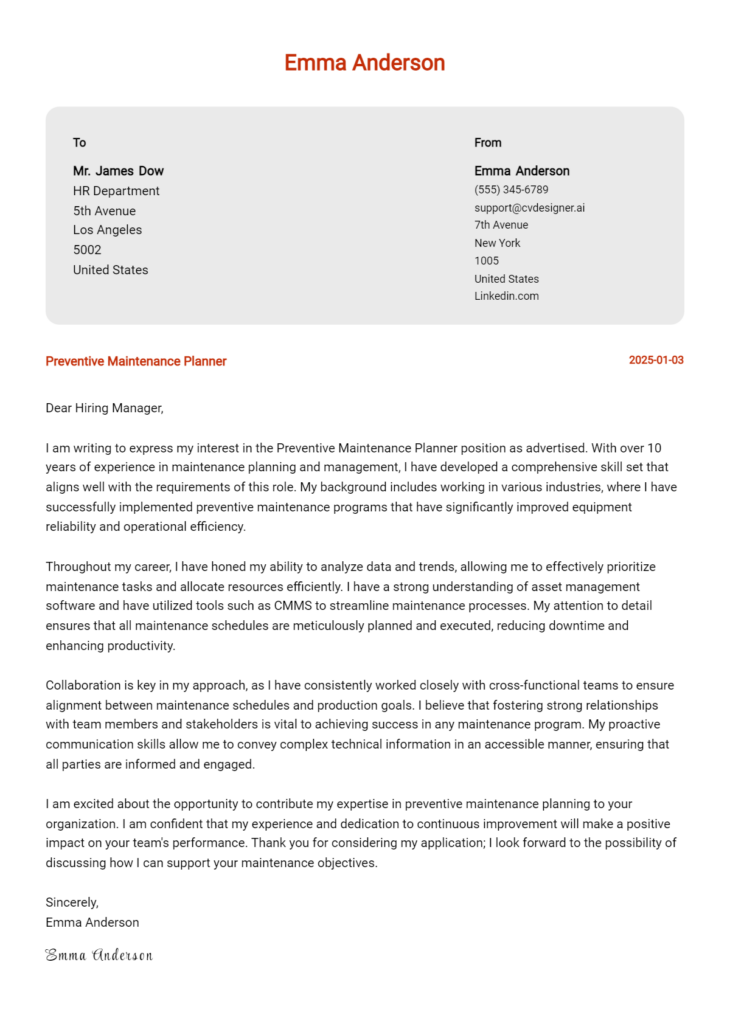Condition Monitoring Technician Cover Letter Examples
Explore additional Condition Monitoring Technician cover letter samples and guides and see what works for your level of experience or role.
How to Format a Condition Monitoring Technician Cover Letter?
Crafting an effective cover letter is crucial for a Condition Monitoring Technician, as it serves as your first opportunity to demonstrate both your technical skills and your keen attention to detail. The way you format your cover letter not only reflects your professionalism but also showcases your ability to systematically approach challenges—an essential quality in condition monitoring. A well-structured letter can capture the hiring manager's interest and set you apart from other candidates in this specialized field.
In this guide, we will outline how to structure your cover letter, including valuable insights and examples tailored specifically for Condition Monitoring Technicians.
We will focus on the essential components of a professional cover letter, including:
- Cover Letter Header
- Cover Letter Greeting
- Cover Letter Introduction
- Cover Letter Body
- Cover Letter Closing
Each section is vital in presenting your qualifications and professionalism effectively. Let’s break down each part to help you create a standout cover letter.
Importance of the Cover Letter Header for a Condition Monitoring Technician
The header of a cover letter is a critical element that sets the tone for the entire document. It provides essential information about the applicant and establishes a professional first impression. For a Condition Monitoring Technician, clarity and professionalism in the header are paramount, as they reflect attention to detail—an essential quality for the role. The header should include the applicant's contact information, the date, and the recipient's details (name, title, company, and address). A well-structured header not only facilitates communication but also showcases the applicant's organizational skills.
Strong Example of a Cover Letter Header
John Doe 123 Main Street City, State, Zip Code john.doe@email.com (123) 456-7890 October 1, 2023 Hiring Manager ABC Manufacturing 456 Industry Road City, State, Zip Code
Weak Example of a Cover Letter Header
John D johndoe@email 10/1/23 Manager ABC Co.
The Importance of a Cover Letter Greeting
The greeting of your cover letter is crucial as it sets the tone for the entire document and establishes a professional rapport with the reader. A well-crafted greeting demonstrates your attention to detail and respect for the hiring manager, while also personalizing your communication. Addressing the hiring manager by name, when possible, shows that you have taken the time to research the company and its personnel, which can make a positive impression. To avoid generic greetings that may come off as impersonal, try to find the name of the hiring manager or the person in charge of recruitment. This can often be done through LinkedIn, the company's website, or by calling the company directly.
Here are examples of strong and weak greetings for a Condition Monitoring Technician cover letter:
Strong Greeting Example
Dear Mr. Smith,
Weak Greeting Example
To Whom It May Concern,
The Importance of a Compelling Cover Letter Introduction for a Condition Monitoring Technician
A well-crafted cover letter introduction is crucial for a Condition Monitoring Technician as it sets the tone for the entire application. It serves as the first impression for the hiring manager, making it essential to capture their attention right away. An effective introduction should not only express the candidate’s enthusiasm for the role but also highlight relevant skills or notable achievements that align with the job requirements. A strong opening can differentiate a candidate from the competition, while a weak introduction may leave a lackluster impression, failing to convey the candidate's qualifications effectively.
Strong Example
Dear [Hiring Manager's Name], I am excited to apply for the Condition Monitoring Technician position at [Company Name], where I can leverage my seven years of experience in predictive maintenance and vibration analysis to contribute to your team's success. My proven track record of improving equipment reliability and reducing downtimes through meticulous monitoring aligns perfectly with your commitment to operational excellence. I am particularly impressed by your innovative approach to condition-based maintenance and am eager to bring my expertise in advanced diagnostic tools to support your objectives.
Weak Example
To Whom It May Concern, I am writing to apply for the Condition Monitoring Technician position. I have some experience in maintenance and think I would be a good fit for the job. I have worked with various types of equipment and am familiar with some monitoring techniques, but I am still learning. Thank you for considering my application.
Purpose of the Cover Letter Body for a Condition Monitoring Technician
The body of a cover letter for a Condition Monitoring Technician serves to effectively showcase the candidate's relevant skills, experiences, and the value they can bring to the organization. This section allows candidates to highlight specific projects or accomplishments that demonstrate their expertise in condition monitoring techniques, such as vibration analysis, infrared thermography, or oil analysis. By detailing quantifiable achievements—like reducing downtime through proactive maintenance strategies or implementing successful monitoring programs—candidates can convey their ability to contribute positively to the company's operational efficiency and reliability.
Strong Example
Dear Hiring Manager, I am excited to apply for the Condition Monitoring Technician position at ABC Industries. In my previous role at XYZ Corp, I led a project that utilized vibration analysis to identify an impending failure in a critical pump system, which allowed us to schedule maintenance before an unplanned outage occurred. This proactive approach resulted in a 30% reduction in downtime and saved the company approximately $50,000 in lost production. My hands-on experience with condition monitoring tools, combined with my commitment to continuous improvement, positions me as a valuable asset to your team. I am eager to bring my expertise to ABC Industries and help enhance your equipment reliability. Sincerely, John Doe
Weak Example
Dear Hiring Manager, I want to apply for the Condition Monitoring Technician job. I worked in a related field and have some experience with maintenance. I believe I can help your company. I have done some tasks similar to what you need, but I don't have specific examples. I am a hard worker and willing to learn more. Best, John Doe
Importance of the Cover Letter Closing for a Condition Monitoring Technician
The closing paragraph of a cover letter is crucial as it reinforces the candidate's qualifications, expresses enthusiasm for the position, and encourages the employer to take the next step, such as reviewing the resume or scheduling an interview. A strong closing leaves a positive impression and highlights the candidate's eagerness, while a weak closing may fail to convey confidence or interest, potentially diminishing the impact of the application.
Strong Example
Thank you for considering my application for the Condition Monitoring Technician position at [Company Name]. With a solid foundation in vibration analysis, thermography, and predictive maintenance, I am excited about the opportunity to contribute to your team and enhance equipment reliability. I am eager to discuss how my skills align with your needs and look forward to the possibility of an interview. Please feel free to review my resume for further details on my experience. Thank you once again for your time and consideration.
Weak Example
I hope you like my application for the Condition Monitoring Technician role. I have some experience that might be useful. Let me know if you want to talk. Thanks.
These tips will assist candidates in crafting an effective cover letter for the role of a Condition Monitoring Technician. A well-written cover letter is essential for standing out in a competitive job market, especially in a technical field. It is crucial to highlight your technical skills, problem-solving abilities, knowledge of the Software Development Life Cycle (SDLC), teamwork experience, and a commitment to continuous learning. By effectively showcasing these attributes, candidates can create a compelling narrative that resonates with potential employers.
Tips for Writing a Cover Letter for a Condition Monitoring Technician
Highlight Technical Skills: Emphasize your proficiency in condition monitoring technologies, such as vibration analysis, thermography, and ultrasound. Mention any relevant certifications or training you've completed. Providing specific examples of how you've applied these skills in previous roles will demonstrate your competence and readiness for the position.
Demonstrate Problem-Solving Abilities: Share instances where you've successfully identified and resolved equipment issues through condition monitoring. Detail your analytical process and the impact your solutions had on operational efficiency. This will illustrate your ability to troubleshoot effectively and contribute positively to the organization's maintenance strategy.
Showcase SDLC Knowledge: If applicable, include your familiarity with the Software Development Life Cycle and how it pertains to condition monitoring systems. Discuss any experience you have with software tools that support condition monitoring, such as CMMS (Computerized Maintenance Management Systems) or predictive maintenance software. This knowledge can set you apart from other candidates.
Emphasize Teamwork Experience: Condition monitoring often involves collaboration with various departments, including maintenance, production, and engineering. Highlight your experience working in teams, your communication skills, and how you've contributed to achieving common goals. Providing examples of successful team projects can demonstrate your ability to work well with others.
Express a Passion for Continuous Learning: The field of condition monitoring is constantly evolving with new technologies and methodologies. Convey your enthusiasm for staying updated on industry trends and your commitment to ongoing professional development. Mention any relevant workshops, courses, or certifications you plan to pursue, which showcases your proactive approach and dedication to growth.
For additional resources, consider exploring cover letter templates or using a cover letter builder to streamline your writing process.
Common Mistakes to Avoid in a Condition Monitoring Technician Cover Letter
Avoiding common mistakes in your cover letter is crucial for making a strong impression as a Condition Monitoring Technician. A well-crafted cover letter can set you apart from other candidates, while oversights can detract from your qualifications. Here are some common mistakes to watch out for:
Generic Salutation: Using a generic greeting like "To Whom It May Concern" can come off as impersonal. Research the hiring manager’s name and address them directly.
Lack of Specificity: Failing to mention specific experiences or skills relevant to condition monitoring can weaken your application. Tailor your letter to highlight specific qualifications and achievements that align with the job description.
Too Lengthy or Too Short: A cover letter that is either too long or too short can lose the reader's interest. Aim for a concise, engaging letter that maintains focus on your relevant skills and experience. For tips on how to format a cover letter, check out this cover letter format.
Spelling and Grammar Errors: Simple mistakes can undermine your professionalism. Always proofread your letter multiple times and consider using tools or asking someone else to review it.
Repeating Your Resume: Your cover letter should complement your resume, not reiterate it. Use this opportunity to showcase your personality and explain how your experiences relate to the role.
Neglecting to Show Enthusiasm: A lack of enthusiasm can make your application seem flat. Express genuine interest in the position and the company to convey your motivation.
Ignoring the Company’s Needs: Failing to address how your skills can benefit the company can be a missed opportunity. Research the organization and align your experiences with their specific goals. For inspiration, refer to some cover letter examples that resonate with condition monitoring roles.
By avoiding these common pitfalls, you can create a compelling cover letter that effectively highlights your qualifications as a Condition Monitoring Technician.
Cover Letter FAQs for Condition Monitoring Technician
What should I include in my cover letter for a Condition Monitoring Technician position?
In your cover letter, you should include your relevant experience in condition monitoring and maintenance, highlighting specific skills such as vibration analysis, thermography, and data interpretation. Begin with a strong introduction that outlines your enthusiasm for the position and the company. Include quantifiable achievements that demonstrate your ability to enhance equipment reliability and reduce downtime. Mention any certifications you hold, such as ISO 18436 or CMRT, as these add credibility to your expertise. Finally, express your eagerness to contribute to the team and your understanding of the company's goals in maintaining operational efficiency.
How can I demonstrate my technical skills in the cover letter?
To effectively demonstrate your technical skills in the cover letter, use specific examples from your work history that showcase your expertise in condition monitoring techniques and tools. Describe scenarios where you successfully diagnosed equipment failures, implemented predictive maintenance strategies, or improved system performance using condition monitoring data. Mention the software or analytical tools you are proficient in, such as MATLAB or PDMS, along with any relevant technologies used in your previous roles. Emphasizing your hands-on experience, along with your ability to analyze and interpret data effectively, will provide a strong indication of your technical capabilities.
How long should my cover letter be?
Your cover letter should be concise and focused, ideally no longer than one page. Aim for 3 to 4 paragraphs that cover the essential points: an engaging introduction, a brief overview of your relevant experience and skills, and a strong closing statement. Each paragraph should provide valuable insights into your qualifications without overwhelming the reader with excessive detail. Remember, hiring managers often skim cover letters, so clarity and brevity are key. Use bullet points for any significant achievements or skills if it enhances readability, but ensure it maintains a professional tone throughout.
Should I customize my cover letter for each job application?
Yes, customizing your cover letter for each job application is crucial. Tailoring your cover letter shows that you have taken the time to understand the specific requirements of the position and the company. Highlight the skills and experiences that are most relevant to the job description, and align your qualifications with the company's goals and values. Mentioning the company's projects or initiatives related to condition monitoring can demonstrate your genuine interest in the role. Personalization can significantly increase your chances of standing out among other candidates and making a positive impression on the hiring manager.
Build your Cover Letter in minutes
Use an AI-powered cover letter builder and have your letter done in 5 minutes. Just select your template and our software will guide you through the process.

